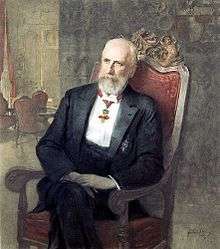Johann II, Prince of Liechtenstein
Johann II (German: Johann Maria Franz Placidus; 5 October 1840 – 11 February 1929), also known as Johann II the Good (Johann II der Gute), was the Prince of Liechtenstein between 1858 and 1929. His reign of 70 years and 91 days is the second-longest of any monarch in European history, after that of Louis XIV of France, and third-longest overall after Louis XIV and Bhumibol Adulyadej of Thailand.
| Johann II | |||||
|---|---|---|---|---|---|
 | |||||
| Prince of Liechtenstein | |||||
| Reign | 12 November 1858 – 11 February 1929 | ||||
| Predecessor | Aloys II | ||||
| Successor | Franz I | ||||
| Born | 5 October 1840 Eisgrub, Margraviate of Moravia, Austrian Empire | ||||
| Died | 11 February 1929 (aged 88) Valtice, First Czechoslovak Republic | ||||
| Burial | Church of the Nativity of the Virgin Mary, Vranov | ||||
| |||||
| House | Liechtenstein | ||||
| Father | Aloys II, Prince of Liechtenstein | ||||
| Mother | Countess Franziska Kinsky of Wchinitz and Tettau | ||||
Early life
Johann II was the elder son of Aloys II, Prince of Liechtenstein and Countess Franziska Kinsky of Wchinitz and Tettau. He ascended to the throne shortly after his 18th birthday, and as such his reign is the longest precisely documented tenure of any European monarch since antiquity in which a regent was never employed.[1] Rama IX of Thailand exceeded this reign by just 35 days.
Law and reform
In 1862, Johann II issued Liechtenstein's first constitution. Later, after Liechtenstein left the German confederation in 1866 and after World War I, Johann II granted a new constitution in 1921. It granted considerable political rights to common Liechtensteiners, the latter making the principality a constitutional monarchy. This constitution survives today but with revisions, most notably in 2003.
Liechtenstein left the German Confederation in 1866. Not long after, the army of Liechtenstein was abolished as it was regarded as an unnecessary expense.
Foreign affairs
Johann II somewhat cooled relations with Liechtenstein's traditional ally, Austria-Hungary and its successor states, to forge closer relations with Switzerland, particularly after World War I. Liechtenstein was neutral during World War I, but the war broke Liechtenstein's alliance with Austria-Hungary and led it to go into a customs union with Switzerland. Late in Johann's reign, in 1924, the Swiss franc became Liechtenstein's official currency.[2]
Patron of the arts
Johann II added much to the Liechtenstein Princely Collections. Although considered a prominent patron of the arts and sciences during his long reign,[3] Johann II was also considered to be rather unsociable and did not participate in social events. He never married or had any children, like several other members of his family.[4]
Between 1905–1920, Schloss Vaduz was renovated and expanded. Prince Johann II did not live in the castle or even Liechtenstein, though his successors would eventually move there in 1938. Schloss Vaduz would be their home.
Upon his death in 1929, Johann II was succeeded by his brother Franz I.
Honours





Ancestry
| Ancestors of Johann II, Prince of Liechtenstein | ||||||||||||||||||||||||||||||||||||||||||||||||||||||||||||||||||||||||||||||||||||||||||||||||||||||||||||||||||||||||||||||||||||||||||||||||||||||||||||||||||||||||||||||||||||||||||||||||||||||||||||||||||||||||||||||||||||||||||||||||||||||||||||||||||||||||||||||||||||||||||||||||||||||||||||||||||||||||||||||||||||||||||||||||||||||||||||||||||||||||||||||||||||||||||||||||||||||||||||||||||||||||||||||||||||||||||||||||||||||||||||||||||||||||||||||||||||||||||||||||||||||||||||||||||||||||||||||||||||||||||||||||||||||||||||||||||||||||||||||||||||||||||||||||||||||||||||||||
|---|---|---|---|---|---|---|---|---|---|---|---|---|---|---|---|---|---|---|---|---|---|---|---|---|---|---|---|---|---|---|---|---|---|---|---|---|---|---|---|---|---|---|---|---|---|---|---|---|---|---|---|---|---|---|---|---|---|---|---|---|---|---|---|---|---|---|---|---|---|---|---|---|---|---|---|---|---|---|---|---|---|---|---|---|---|---|---|---|---|---|---|---|---|---|---|---|---|---|---|---|---|---|---|---|---|---|---|---|---|---|---|---|---|---|---|---|---|---|---|---|---|---|---|---|---|---|---|---|---|---|---|---|---|---|---|---|---|---|---|---|---|---|---|---|---|---|---|---|---|---|---|---|---|---|---|---|---|---|---|---|---|---|---|---|---|---|---|---|---|---|---|---|---|---|---|---|---|---|---|---|---|---|---|---|---|---|---|---|---|---|---|---|---|---|---|---|---|---|---|---|---|---|---|---|---|---|---|---|---|---|---|---|---|---|---|---|---|---|---|---|---|---|---|---|---|---|---|---|---|---|---|---|---|---|---|---|---|---|---|---|---|---|---|---|---|---|---|---|---|---|---|---|---|---|---|---|---|---|---|---|---|---|---|---|---|---|---|---|---|---|---|---|---|---|---|---|---|---|---|---|---|---|---|---|---|---|---|---|---|---|---|---|---|---|---|---|---|---|---|---|---|---|---|---|---|---|---|---|---|---|---|---|---|---|---|---|---|---|---|---|---|---|---|---|---|---|---|---|---|---|---|---|---|---|---|---|---|---|---|---|---|---|---|---|---|---|---|---|---|---|---|---|---|---|---|---|---|---|---|---|---|---|---|---|---|---|---|---|---|---|---|---|---|---|---|---|---|---|---|---|---|---|---|---|---|---|---|---|---|---|---|---|---|---|---|---|---|---|---|---|---|---|---|---|---|---|---|---|---|---|---|---|---|---|---|---|---|---|---|---|---|---|---|---|---|---|---|---|---|---|---|---|---|---|---|---|---|---|---|---|---|---|---|---|---|---|---|---|---|---|---|---|---|---|---|---|---|---|---|---|---|---|---|---|---|---|---|---|---|---|---|---|---|---|---|---|---|---|---|---|---|---|---|---|---|---|---|---|---|---|---|---|---|---|---|---|---|---|---|---|---|---|---|---|---|---|---|---|---|---|---|---|---|---|---|---|---|---|---|---|---|---|---|---|---|---|---|---|---|---|---|---|---|---|---|---|---|---|---|---|---|---|---|---|---|---|---|---|---|---|---|---|---|---|---|---|---|---|---|---|---|---|---|---|---|---|---|---|---|---|---|---|---|---|---|---|---|---|---|---|---|---|---|---|---|---|---|---|---|---|---|---|
| ||||||||||||||||||||||||||||||||||||||||||||||||||||||||||||||||||||||||||||||||||||||||||||||||||||||||||||||||||||||||||||||||||||||||||||||||||||||||||||||||||||||||||||||||||||||||||||||||||||||||||||||||||||||||||||||||||||||||||||||||||||||||||||||||||||||||||||||||||||||||||||||||||||||||||||||||||||||||||||||||||||||||||||||||||||||||||||||||||||||||||||||||||||||||||||||||||||||||||||||||||||||||||||||||||||||||||||||||||||||||||||||||||||||||||||||||||||||||||||||||||||||||||||||||||||||||||||||||||||||||||||||||||||||||||||||||||||||||||||||||||||||||||||||||||||||||||||||||
References
- Worldstatesmen.org – Liechtenstein Retrieved 16 December 2007
- Welcome.li Yellow Pages of Liechtenstein Archived 6 October 2007 at the Wayback Machine Retrieved 16 December 2007
- Portal of the Principality of Liechtenstein – Princely House – Prince Johann II Retrieved 16 December 2007
- Staat Hannover (1865). Hof- und Staatshandbuch für das Königreich Hannover: 1865. Berenberg. p. 79.
- Boettger, T. F. "Chevaliers de la Toisón d'Or – Knights of the Golden Fleece". La Confrérie Amicale. Retrieved 25 June 2019.
- "A Szent István Rend tagjai" Archived 22 December 2010 at the Wayback Machine
- Justus Perthes, Almanach de Gotha (1922) page 55
- Hof- und Staats-Handbuch des Königreich Bayern (1908), "Königliche Orden" p. 7
External links
- Works by or about Johann II, Prince of Liechtenstein at Internet Archive
- Princely House of Liechtenstein
Johann II, Prince of Liechtenstein House of Liechtenstein Born: 5 October 1840 Died: 11 February 1929 | ||
| Regnal titles | ||
|---|---|---|
| Preceded by Aloys II |
Prince of Liechtenstein 1858–1929 |
Succeeded by Franz I |